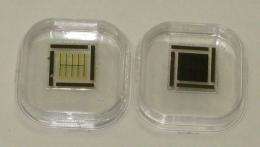The PV cell prototyped at the Kyoto Institute of Technology by adding cobalt to a p-type GaN thin film and laminating an n-type material (right). The cell with an absorbing layer measures 10 x 10mm. The surrounding thin rectangular patterns are electrodes. And the p-type GaN thin film without cobalt (left). Image via: Tech on.
(PhysOrg.com) -- A prototype of a new type of photovoltaic (PV) cell that generates electricity from visible, infrared and ultraviolet light has been demonstrated by a group of Japanese scientists. It could lead to the development of a highly-efficient PV cell in the future, without needing multijunction cells.
The research was led by Associate Professor Saki Sonoda of the Kyoto Institute of Technology. The prototype cell has a high open voltage (Voc) at around two volts, but a low energy conversion efficiency. Sonada and the team hope the conversion rates can be improved.
Photovoltaic materials convert light to electricity at the atomic level by absorbing photons of light and releasing electrons that can be captured to produce an electric current. Most PV cells are multijunction devices, with single junction cells stacked in descending order of band gap. The cell at the top captures high-energy photons, while those at the bottom with lower band gaps capture the lower energy photons. The new cell is able to capture photons with a wide range of energies in a single junction cell.
The team made the 10 mm square PV cell by adding elements such as manganese (Mn) or cobalt (Co) to the transparent semiconductor material gallium nitride (GaN). When the element is added, the absorption coefficient of GaN is higher, allowing a much wider spectrum of light to be absorbed, including infrared, visible and ultraviolet. A cell made from p-type GaN with added Mn or Co is transparent and black, whereas GaN without additions is not.
Manganese and cobalt are 3d transition metals, which are elements in which the number of electrons in the 3d orbit (inside the outermost orbit) increases as the number of protons in the nucleus (and hence the atomic number) increases. Other well-known 3d transition metals include titanium (Ti), iron (Fe), copper (Cu) nickel (Ni) and zinc (Zn).
The scientists tried several 3d transition metals with GaN and obtained good results with many of them, including manganese and cobalt. Other researchers have tried adding indium (In) to gallium nitride PV cells with the aim of narrowing the band gap to enable it to absorb a wider wavelength band of visible light.
The prototype was demonstrated during a 90-minute lecture at the 57th Spring Meeting of the Japan Society of Applied Physics on March 19.
© 2010 PhysOrg.com






















